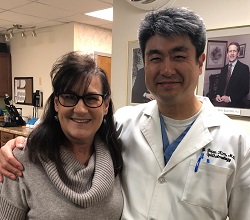Please click on the link below to watch a testimonial video from one of our patients:
https://www.youtube.com/watch?v=JNME7Ns70v4
The cornea is the clear domed surface of the eye, and it is essential for good vision. If the cornea becomes injured, deformed, or diseased, it can cause vision loss or blindness. Corneal transplantation (keratoplasty) removes the diseased cornea and replaces it with a new cornea. Corneal transplantation is an effective surgery which can restore vision that would otherwise be lost.
Corneal transplantation is indicated for a variety of conditions which include but are not limited to corneal scars or infections, Fuchs endothelial dystrophy, keratoconus, and pseudophakic bullous keratopathy.
PKP (Penetrating Keratoplasty)
The first corneal transplant was performed in 1905 by Eduard Zirm (Olomouc Eye Clinic, now Czech Republic), making it one of the first types of organ transplant surgery ever performed on human beings. Penetrating Keratoplasty has been available for many decades and the procedure involves replacing the diseased cornea using a cookie-cutter technique. The old cornea is cut entirely out and a new cornea is cut and sewn onto the patient's eye with micro-stitches. This surgery has been performed for many decades with great success but it has its limitations. PKP requires the removal of the entire cornea which means it removes both the unhealthy and healthy corneal tissue. This means that otherwise healthy tissue needs to be removed with PKP. Other concerns include tissue rejection, infection, bleeding, stitch breakage, irregular astigmatism, and wound gape or instability. The endothelium, which is the innermost layer of the cornea, is responsible for endothelial rejection. When this is removed and replaced, tissue rejection risk is higher. Also, since stitches are required to secure the tissue onto the eye, they can cause distortion (irregular astigmatism), can break, and can lead to infections or wound instability.
Recent advances in corneal transplantation techniques allow for the selective removal of only the diseased part of the cornea which allows for safer surgery, lower risks for rejection, faster healing, and better quality of vision.
DSAEK (Descemet's Stripping Automated Endothelial Keratoplasty)
DSAEK is the selective removal of the innermost layer of the cornea, descemet's and endothelium, such that the tissue is attached with the help of a gas bubble and the suction effect of the tissue onto the patient's cornea. This is beneficial because only a small layer of cornea is removed instead of the entire cornea. And no stitches are needed to keep the tissue in place. This translates to less invasive surgery, faster surgery, less risk, less distortion, and faster visual recovery. DSAEK is indicated for the treatment of Fuchs endothelial dystrophy, pseudophakic bullous keratoplasty, and other endothelial diseases.
DALK (Deep Anterior Lamellar Keratoplasty
DALK is the selective removal of the outermost layers of the cornea, everything except descemet's and endothelium. Although stitches are required, the eye is not cut open completely which reduces the risk for infection and bleeding complications. And because the endothelium is not removed, patients are spared the risk for endothelial tissue rejection. It is less invasive surgery which results in safer and faster visual recovery. DALK is indicated for corneal scars, keratoconus, pellucid marginal degeneration, and other front-surface corneal diseases.
Following Surgery
Following corneal transplantation, you will be taken to a recovery room to rest. A protective shield will be placed over your eye, and you will need to wear this shield until your examination with your eye surgeon the next day. This shield protects your eye from accidental bumps and rubs, and it is important that you continue to wear it as directed by your surgeon. Please plan to have someone drive you home, as you will not be able to drive for several days.
You will need to use eye drops to prevent infection and to help the cornea heal. The better you adhere to your doctor's instructions, the faster and more smoothly the recovery process. You can expect to see your eye surgeon every 1-2 weeks the first month following surgery, and then every 2-3 weeks for the next 2 months.
Risks and Complications
Complications following corneal transplants are uncommon, but, as with any surgical and transplant procedure, there are certain risks. These include:
- Rejection of the donor tissue
- Bleeding
- Infection of the eye
- Glaucoma
- Swelling
If you experience any of these problems, please contact our office right away.
Corneal Transplantation in Northwest Georgia
Did you know that we have the area's only fellowship-trained corneal specialist in Northwest Georgia? Brian Kim, MD offers extensive training and experience with natural and synthetic corneal transplantation techniques. Subspecialists like Dr. Kim usually practice in larger cities like Atlanta, so we are happy that our patients don't have to drive far away while receiving expert corneal care locally.
If you live in the North Georgia area including Dalton, Calhoun, Ft. Oglethorpe, Chatsworth, or Ellijay, and would like to know more about corneal transplantation, please contact us to schedule your corneal transplant consultation. We will answer any questions you have, and we look forward to serving you.